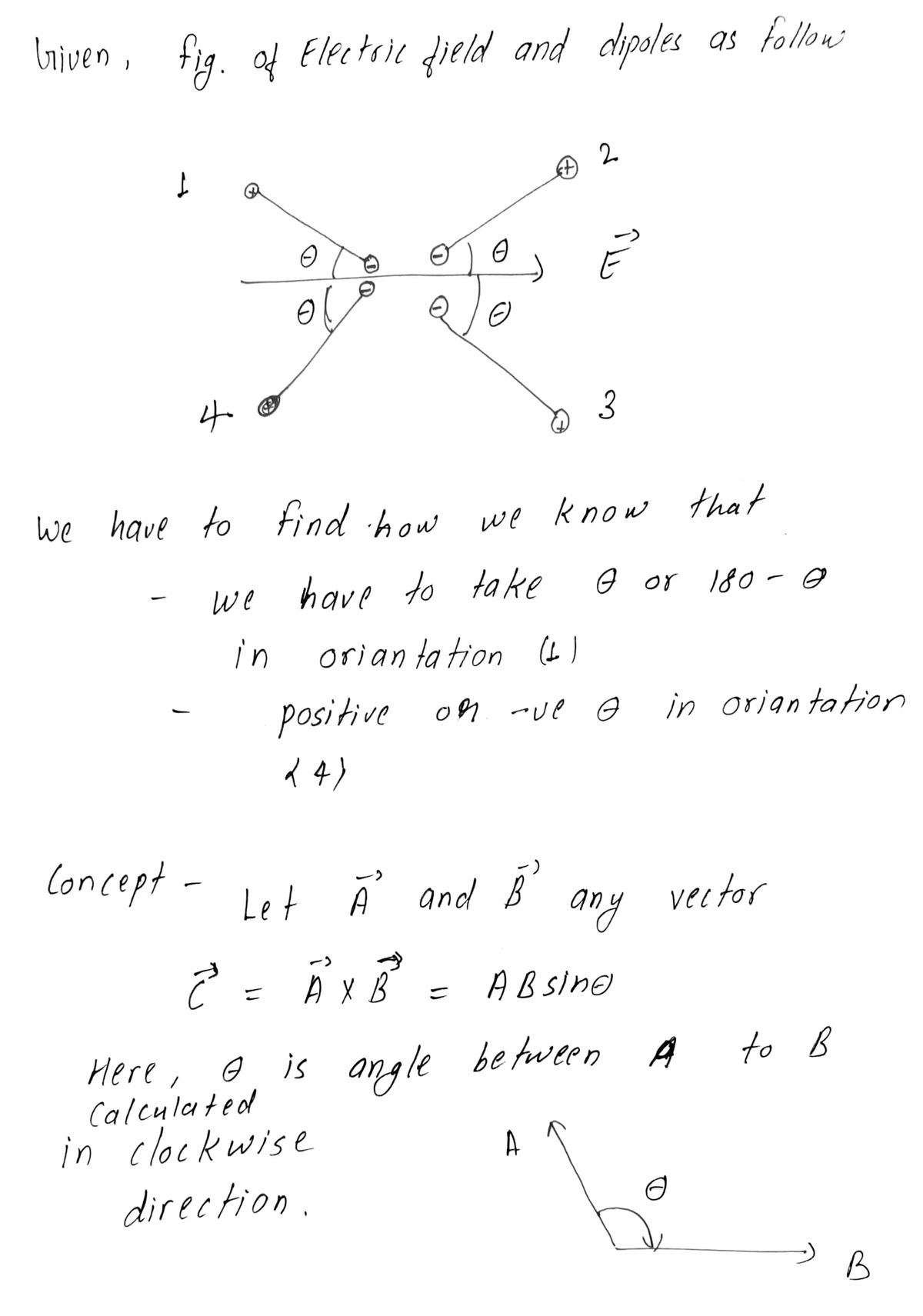The figure shows four orientations of an electric dipole in an external field. For each of the four dipoles, give the angle between the p vector (dipole moment) and the E vector (electric field vector) that is used in the formula for torque: torque = p E sin (phi) where phi is the angle between the p and E vectors. For example, how do you know if you use theta or 180 - theta for orientation (1); do you use theta or negative theta for orientation 4?
The figure shows four orientations of an electric dipole in an external field. For each of the four dipoles, give the angle between the p vector (dipole moment) and the E vector (electric field vector) that is used in the formula for torque: torque = p E sin (phi) where phi is the angle between the p and E vectors. For example, how do you know if you use theta or 180 - theta for orientation (1); do you use theta or negative theta for orientation 4?
College Physics
11th Edition
ISBN:9781305952300
Author:Raymond A. Serway, Chris Vuille
Publisher:Raymond A. Serway, Chris Vuille
Chapter1: Units, Trigonometry. And Vectors
Section: Chapter Questions
Problem 1CQ: Estimate the order of magnitude of the length, in meters, of each of the following; (a) a mouse, (b)...
Related questions
Question
The figure shows four orientations of an electric dipole in an external field. For each of the four dipoles, give the angle between the p vector (dipole moment) and the E vector (electric field vector) that is used in the formula for torque: torque = p E sin (phi) where phi is the angle between the p and E vectors. For example, how do you know if you use theta or 180 - theta for orientation (1); do you use theta or negative theta for orientation 4?

Transcribed Image Text:(1) +
(3) +
Ө
Ө
Ө
Ө
+ (2)
E
+ (4)
Expert Solution
Step 1

Step by step
Solved in 2 steps with 2 images

Follow-up Questions
Read through expert solutions to related follow-up questions below.
Follow-up Question
Could you please also give the angles for dipoles (2) and (3) along with the explanation, as was given above for dipoles (1) and (4)?
Solution
Knowledge Booster
Learn more about
Need a deep-dive on the concept behind this application? Look no further. Learn more about this topic, physics and related others by exploring similar questions and additional content below.Recommended textbooks for you

College Physics
Physics
ISBN:
9781305952300
Author:
Raymond A. Serway, Chris Vuille
Publisher:
Cengage Learning

University Physics (14th Edition)
Physics
ISBN:
9780133969290
Author:
Hugh D. Young, Roger A. Freedman
Publisher:
PEARSON

Introduction To Quantum Mechanics
Physics
ISBN:
9781107189638
Author:
Griffiths, David J., Schroeter, Darrell F.
Publisher:
Cambridge University Press

College Physics
Physics
ISBN:
9781305952300
Author:
Raymond A. Serway, Chris Vuille
Publisher:
Cengage Learning

University Physics (14th Edition)
Physics
ISBN:
9780133969290
Author:
Hugh D. Young, Roger A. Freedman
Publisher:
PEARSON

Introduction To Quantum Mechanics
Physics
ISBN:
9781107189638
Author:
Griffiths, David J., Schroeter, Darrell F.
Publisher:
Cambridge University Press

Physics for Scientists and Engineers
Physics
ISBN:
9781337553278
Author:
Raymond A. Serway, John W. Jewett
Publisher:
Cengage Learning

Lecture- Tutorials for Introductory Astronomy
Physics
ISBN:
9780321820464
Author:
Edward E. Prather, Tim P. Slater, Jeff P. Adams, Gina Brissenden
Publisher:
Addison-Wesley

College Physics: A Strategic Approach (4th Editio…
Physics
ISBN:
9780134609034
Author:
Randall D. Knight (Professor Emeritus), Brian Jones, Stuart Field
Publisher:
PEARSON